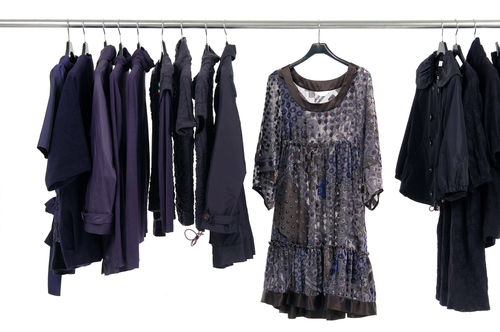Teresa Hunsaker, from Utah State University helps us decipher when machine washing is an option.
Some items marked “Dry Clean” can be safely home laundered. The Care Labeling law states only one method of cleaning must be communicated to the consumer, not all acceptable methods. [The dry cleaning processes means a chemical cleaning process, not a ‘dry’ method.]
What will affect the success of home laundering instead of dry cleaning are: fiber type, garment construction, fabric construction, dyes, printing processes, finishes, trimmings (example: beads), soil, and stains.
When washing at home remember to always use cool/cold water, a hand process (machine washing may be too rough), and a gentle cleaner like hand dishwashing detergent or certainly Woolite. Never use bleaches, regular laundry cleaners, fabric softeners, or rinse additives. Do not twist or wring the garment as some items can be damaged by twisting or wringing them. Some protein fibers (example silk and wools should be kept away from heat sources and sunlight.
When drying the garment dry it in such a way as not to stretch the garment. If necessary, or if in doubt, lay the garment flat on lots of towels which are changed when they absorb too much water. Do not try to dry in the dryer as the heat and/or agitation can cause damage to the garment. Home laundering of “dry clean” items has to be a hand process.
It’s important when caring for your clothes is know when not to home launder. It is best to take a garment to a professional when:
• There are spots or stains on the garment (some home remedies can remove the dye).
• The garment is made from acetate fibers.
• It is a rayon garment. They often shrink in water. Rayon is a finicky fiber—it will shrink, wrinkle terribly, lose its “hand” and not all consistently either.
• There is a special finish on the garment. Such would include fabrics that are stiff. These may have a stabilizing finish to maintain the stiffness.
• The garment has a lot of structure, such as a suit. This would be extremely difficult to iron and not worth saving a few dollars. This also applies to a garment which requires a lot of attention when ironing (pleats).
• The garment is leather or suede.
• The garment is really special to you, or was expensive.
• The garment says not to professionally iron.
• The garment is new and not of a fiber you have successfully home laundered.
• Finally, if the feel, or hand, of the garment is important to you, as may be with a silk garment, dry clean it.
Another option is the “dry clean at home” kits available in the supermarket on the laundry cleaning supply aisle. The items these kits work best on are: dresses, blouses, unlined trousers, skirts, silks, jackets, sweaters. They are not recommended for: suede, leather, furs, velvet, or those with compact dryers.
Start by spot cleaning the item by gently rubbing it with the stain remover provided in the dry cleaning kit. The stain remover is usually made of a detergent mixed with water and the kit usually includes a blotting pad. The next step is to either place in the bag provided, or place right into the dryer—use and care instructions will be included.
Items not recommended to take to the cleaner are garments with beads, sequins, delicate trims, and/or glued-on appliques. I discovered that with my wedding dress. The glues have been known to dissolve and the trims can dissolve in the chemical process or melt with the heat.
If you can’t imagine putting your “Dry-Clean Only” articles into a washing machine with water, consider this: the term “dry cleaning” is a misnomer. Granted, the process that businesses use doesn’t involve water. Most dry cleaning establishments immerse clothing into a liquid chemical called Perchloroethylene, or “Perc” for short. Perc doesn’t shrink or discolor clothing. That’s the good news. The bad news is, this chemical causes air pollution. It’s also known to cause cancer.
You’ll have to use your own judgment on what clothing you’ll put in your washing machine. Just remember, the more you can launder yourself, the more money you’ll save on your dry cleaning bill.
Resource:
Whirlpool Institute of Fabric Science –
www.instituteoffabricscience.org
www.eversave.com
Consumer Reports
For more information about this or any consumer issue, call USU Extension Weber County at (801) 399-8200 or online at www.extension.usu.edu/weber.















Add comment